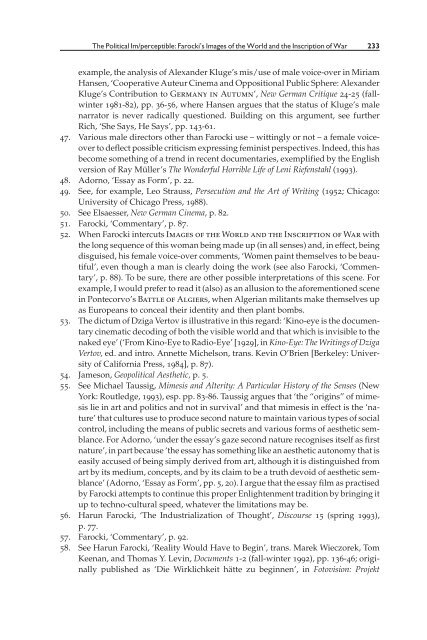You also want an ePaper? Increase the reach of your titles
YUMPU automatically turns print PDFs into web optimized ePapers that Google loves.
The Political Im/perceptible: Farocki’s Images of the World and the Inscription of War 233<br />
example, the analysis of Alexander Kluge’s mis/use of male voice-over in Miriam<br />
Hansen, ‘Cooperative Auteur Cinema and Oppositional Public Sphere: Alexander<br />
Kluge’s Contribution to Germany in Autumn’, New German Critique 24-25 (fallwinter<br />
1981-82), pp. 36-56, where Hansen argues that the status of Kluge’s male<br />
narrator is never radically questioned. Building on this argument, see further<br />
Rich, ‘She Says, He Says’, pp. <strong>14</strong>3-61.<br />
47. Various male directors other than Farocki use – wittingly or not – a female voiceover<br />
to deflect possible criticism expressing feminist perspectives. Indeed, this has<br />
become something of a trend in recent documentaries, exemplified by the English<br />
version of Ray Müller’s The Wonderful Horrible Life of Leni Riefenstahl (1993).<br />
48. Adorno, ‘Essay as Form’, p. 22.<br />
49. See, for example, Leo Strauss, Persecution and the Art of Writing (1952; Chicago:<br />
University of Chicago Press, 1988).<br />
50. See Elsaesser, New German Cinema, p. 82.<br />
51. Farocki, ‘Commentary’, p. 87.<br />
52. When Farocki intercuts Images of the World and the Inscription of War with<br />
the long sequence of this woman being made up (in all senses) and, in effect, being<br />
disguised, his female voice-over comments, ‘Women paint themselves to be beautiful’,<br />
even though a man is clearly doing the work (see also Farocki, ‘Commentary’,<br />
p. 88). To be sure, there are other possible interpretations of this scene. For<br />
example, I would prefer to read it (also) as an allusion to the aforementioned scene<br />
in Pontecorvo’s Battle of Algiers, when Algerian militants make themselves up<br />
as Europeans to conceal their identity and then plant bombs.<br />
53. The dictum of Dziga Vertov is illustrative in this regard: ‘Kino-eye is the documentary<br />
cinematic decoding of both the visible world and that which is invisible to the<br />
naked eye’ (‘From Kino-Eye to Radio-Eye’ [1929], in Kino-Eye: The Writings of Dziga<br />
Vertov, ed. and intro. Annette Michelson, trans. Kevin O’Brien [Berkeley: University<br />
of California Press, 1984], p. 87).<br />
54. Jameson, Geopolitical Aesthetic, p. 5.<br />
55. See Michael Taussig, Mimesis and Alterity: A Particular History of the Senses (New<br />
York: Routledge, 1993), esp. pp. 83-86. Taussig argues that ‘the “origins” of mimesis<br />
lie in art and politics and not in survival’ and that mimesis in effect is the ‘nature’<br />
that cultures use to produce second nature to maintain various types of social<br />
control, including the means of public secrets and various forms of aesthetic semblance.<br />
For Adorno, ‘under the essay’s gaze second nature recognises itself as first<br />
nature’, in part because ‘the essay has something like an aesthetic autonomy that is<br />
easily accused of being simply derived from art, although it is distinguished from<br />
art by its medium, concepts, and by its claim to be a truth devoid of aesthetic semblance’<br />
(Adorno, ‘Essay as Form’, pp. 5, 20). I argue that the essay film as practised<br />
by Farocki attempts to continue this proper Enlightenment tradition by bringing it<br />
up to techno-cultural speed, whatever the limitations may be.<br />
56. Harun Farocki, ‘The Industrialization of Thought’, Discourse 15 (spring 1993),<br />
p. 77.<br />
57. Farocki, ‘Commentary’, p. 92.<br />
58. See Harun Farocki, ‘Reality Would Have to Begin’, trans. Marek Wieczorek, Tom<br />
Keenan, and Thomas Y. Levin, Documents 1-2 (fall-winter 1992), pp. <strong>13</strong>6-46; originally<br />
published as ‘Die Wirklichkeit hätte zu beginnen’, in Fotovision: Projekt
















